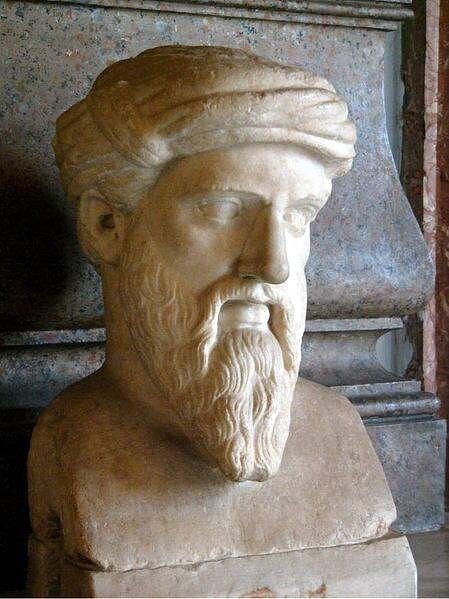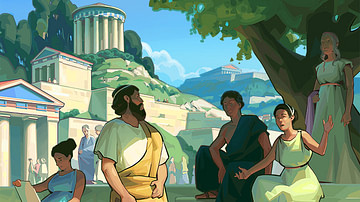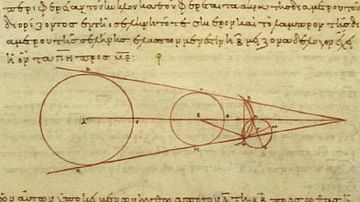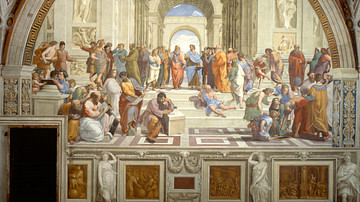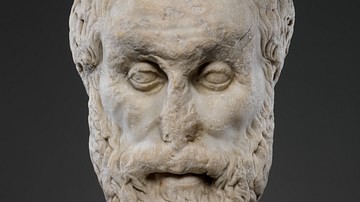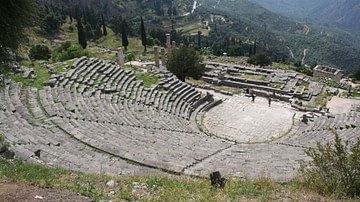
Philolaus (l. c. 470 to c. 385 BCE) was a Pythagorean philosopher who claimed that fire was the first cause of existence and heat the underlying source of human life. He is best known for his pyrocentric model of the universe, which replaced Earth as the center of the solar system with a central fire, around which all else revolved.
Usually referenced as Philolaus of Croton, he is also known as Philolaus of Tarentum and, sometimes, of Metapontum, all cities of the region known as Magna Graecia in southern Italy, settled by the Greeks. Nothing is known of his life, and his works exist only in fragments, but in his time, he was highly influential. He may have been a student of Pythagoras (l. c. 571 to c. 497 BCE), though this claim is challenged, but was certainly influenced by Pythagorean beliefs. He is cited by Plato (l. 428/427-348/347 BCE) in his dialogue of the Phaedo as the teacher of the Pythagoreans Simmias and Cebes and is known to have been the teacher of the Pythagorean astronomer and statesman Archytas of Tarentum (l. c. 435 to c. 360 BCE) as well as the first to write a book (or books) on Pythagorean philosophy.
Philolaus' works drew on the tradition of the Pre-Socratic Philosophers (those who wrote before the time of Socrates of Athens, l. 470/469-399 BCE) whose primary focus was defining a first cause of existence. Thales of Miletus (l. c. 585 BCE), Anaximander (l. c. 610 to c. 546 BCE), and Anaximenes (l. c. 546 BCE) all suggested their own concepts of this first cause and Pythagoras would offer his own as well as insights into the nature of the human condition.
Philolaus seems to have combined Pythagorean thought with his own views on the first cause to present a view of the universe comprised of limited and unlimited aspects, the latter held in place by the former, which operated seamlessly through a mathematical, musical harmony. The nature of a given thing was unlimited, but the form it took limited it spatially. Philolaus was the first Greek philosopher to suggest that the Earth was not the center of the universe but a planet like any other and that all the planets, the Sun, and the Moon, revolved around a central fire whose essence was limitless but, like all else, was limited spatially. His beliefs are thought to have influenced Plato, Aristotle (l. 384-322 BCE), and Aristarchus of Samos (l.c. 310 to c. 230 BCE), who first advocated for a heliocentric model of the solar system.
Pre-Socratics & the First Cause
The Pre-Socratic philosophers are often cited as the 'first scientists' in that they attempted to formulate systems to explain the nature of existence without reference to the supernatural. In Thales' time, the polytheistic Greek religion explained the origin of the universe and humanity in terms of the gods. Zeus had defeated the forces of chaos and established order, and that order was then maintained by him and his fellow deities. This is the worldview that informs the 8th-century BCE works of Homer and Hesiod and was the underlying form of Greek culture, which understood the gods as simply all-powerful and immortal versions of humanity. Scholar Robin Waterfield elaborates:
Anthropomorphism is the outstanding characteristic of Homeric religion and hence of Greek religion as a whole. Nor was it a half-hearted anthropomorphism. Not only did the gods have family trees, they also had family squabbles. Being pictured as super-humans, they could not be omnipresent or omniscient. We even hear of the gods washing, walking, eating, drinking, being wounded, and making love. The gods in this respect are just many times more powerful than petty humans. (xxi)
Thales, defined by later Greek writers as the 'first philosopher', departed from this vision by asking what 'basic stuff' the universe consisted of, what was the first cause of existence, without reference to these gods. As atheism was considered a capital crime, the Pre-Socratics seem to have phrased their suggestions to fit within a theistic model without relying upon it. Thales claimed the first cause was water because, when water was heated, it became vapor (air), when cooled it became ice (solid), and it sustained human, plant, and animal life. In the extant fragments of his work, he does not deny the existence of gods; his work could be interpreted as pointing to the first element the gods used in creating life.
Thought to be Thales' student, Anaximander developed the claim that all came from a creative force known as the apeiron, which was unlimited and brought all things into existence, maintained them according to the pattern it set, and dissolved them to create new forms from the same boundless material. Anaximander followed with his claim that air was the first cause because it changed forms through rarefaction and condensation, was necessary for life, and sustained living things.
Pythagoras introduced the more abstract claim of number as the first cause in that number has no beginning or end, defines entities by establishing parameters, and is both one and many in that numbers share a commonality in designating an amount but each a different one. Numbers are limited in their sequence 1-10 but are limitless in how that sequence can be continued (11-20, 21-30, etc). Numbers were not just units of measurement to Pythagoras, however, but representations of truth.
The Pythagorean number is based on the monad – a dot in the center of a circle – symbolizing the concept of One, which Pythagoras held to be the representation of the first cause or essence of existence. The monad becomes a dyad through self-reflection, becoming two circles sharing the same center and, when a horizontal line is drawn across their intersection, an equilateral triangle is suggested, turning the dyad into the triad. This process is repeated up through the decad (representing 10) and, in this way, Pythagoras explained how the first cause gave rise to the many different aspects of observable existence.
Pythagoras & Philolaus
Philolaus was aware of these previous claims regarding the first cause and, certainly, was well-versed in Pythagorean thought. To Pythagoras, "ten is the very nature of number. All Greeks and barbarians alike count up to ten and, having reached ten, revert again to the unit" (Baird, 15). Ten was understood as the perfect number as it was the culmination of the division of the one-which-became-many whose units could be added together to form the whole again of ten. Ten then became the basis for sequences, which followed without limit. The later historian Diogenes Laertius (l. c. 180-240 CE) summarizes the Pythagorean view of numbers:
From numbers [come] points, from points, lines, from lines, plane figures, from plane figures, solid figures, from these sensible bodies, of which the elements are four: fire, water, earth, and air. These change and are wholly transformed and from them arises a cosmos animate, intelligent, and spherical, embracing the earth (itself spherical and inhabited all around as its center. (VIII.25/Robinson, 77)
Diogenes Laertius is often regarded as an unreliable source as he failed to cite his sources, and a number of his passages have been challenged, but in this instance, he presents original Pythagorean thought as supported by extant fragments. The process described was suggested by musical intervals understood when Pythagoras was listening to the instrument known as the monochord. Scholar John Mansley Robinson comments:
The monochord, as the name indicates, is a one-stringed instrument. By stopping the string at one point, plucking it, then stopping it at another, and plucking it again, it is possible to establish a relation between the sounds produced and the length of the vibrating string. [The points at which the string is stopped] corresponds to the octave, the major fifth, and the major fourth, the chief consonances of Greek music. But they do not merely correspond to them; they make them what they are. And it was in recognizing this that the genius of Pythagoras lay, for it opened his eyes to the possibility that all order is at bottom capable of being understood and expressed in terms of number. (69)
Philolaus took this concept and applied it to the model of the universe suggested by Pythagoras and the earlier Pre-Socratic philosophers. He rejected the suggestions of Thales, Anaximander, and Anaximenes because water and air were aspects of the observable world – and so could not be the first cause – while Anaximander's apeiron was too speculative. Starting from Pythagoras' claim that all originated from, and was ordered by, number, Philolaus arrived at his pyrocentric model of the universe in which ten planets circled a central fire, both limited and limitless, and Earth – no longer the center of that universe – was just one of them.
Philolaus’ Philosophy
Philolaus' philosophy was primarily concerned with the nature of existence although, based on some extant fragments and commentaries by later writers, he also addressed the human condition. His views are clearly informed by Pythagorean thought but, since Pythagoras wrote nothing down himself, it is unclear how much of Philolaus' work is original or simply a restating of Pythagorean philosophy except for his claims regarding the fate of the soul after death and his astronomical model based on the central fire. Philolaus' discussion of the origin of the cosmos begins:
The first composite entity, the One, which is in the center of the Sphere, is called the Hearth. (Freeman 74, fragment 7)
This "hearth" is the central fire and sits like the monad in the sphere of the observable universe and, when divided like the monad, gives birth to the perfect ten of the planets. This One, like everything else, may be understood through number:
Actually, everything that can be known has a Number; for it is impossible to grasp anything with the mind or to recognize it without [Number]. (Freeman, 74, fragment 4)
With the central fire at the center, the first planet was the Counterearth (undefined), then Earth, the Moon, the Sun, Mercury, Venus, Mars, Jupiter, Saturn, and the fixed stars at the far rim. As with much of Philolaus' philosophy, the Counterearth is never explained, and some scholars believe it was added only to bring the number of 'planets' up to ten so they would match the Pythagorean concept of perfection. The planets all moved around the central fire from west to east, each with their own revolution, most of them revolving slowly but Earth completing a rotation in 24 hours. As the Sun moves more slowly than the Earth, daylight lasts as long as the Earth is on one side of the central fire and in the Sun's path, while night comes once Earth is on the far side of the hearth.
The planets are able to make their circuit owing to a harmonious balance of what Philolaus called the Unlimited and the Limiting:
Nature in the universe was fitted together from the Non-Limited and the Limiting, both the universe as a whole and everything in it. (Freeman, 73, fragment 1)
Although Philolaus never defines these terms, the Unlimited seems to refer to the essence of a thing while the Limiting is the space or form it takes. Water, for example, is limitless in essence as it shares its fundamental nature with water everywhere in the world but is limited in the form of a stream, river, or ocean. The central fire's essence is unlimited, but the fire is limited by its point in space. It does not move from this point because of the harmonious balance of number that holds all things together:
This is how it is with Nature and Harmony: The Being of things is eternal, and Nature itself requires divine and not human intelligence; moreover, it would be impossible for any existing thing to be even recognized by us if there did not exist the basic Being of the things from which the universe was composed, namely, both the Limiting and the Non-Limited. But since these Elements exist as unlike and unrelated, it would clearly be impossible for a universe to be created with them unless harmony was added [and] in which way this harmony did come into being. Now, the things which were like and related needed no harmony; but the things which were unlike and unrelated and unequally arranged are necessarily fastened together by such a harmony, through which they are destined to endure in the universe. (Freeman, 74, fragment 6)
Philolaus claims (above and elsewhere) that human beings could not grasp the truth of the nature of reality but could glimpse it, or at least approach an understanding of it, through music which was informed by mathematics, by number. The harmony he speaks of is understood to consist of musical notes which resonate and hold the Unlimited within the Limiting:
The content of the Harmony is the major fourth and the major fifth; the fifth is greater than the fourth by a whole tone; for from the highest string (lowest note) to the middle is a fourth, and from the middle to the lowest string (highest note) is a fifth. From the lowest to the third string is a fourth, from the third to the highest string is a fifth. Between the middle and third strings is a tone. The major fourth has the ratio 3:4, the fifth 2:3, and the octave 1:2. Thus the Harmony consists of five whole tones and two semi-tones, the fifth of three tones and a semitone, and the fourth consists of two tones and semitone. (Freeman, 74, fragment 6)
This concept of music as mathematical, celestial, harmony – known as universal music or the music of the spheres – was another Pythagorean concept, and, again, it is unclear if it is original to Philolaus or Pythagoras. Music, Philolaus claimed, originated in number like everything else, but number expressed its harmonizing influence in the universe through music.
Harmony & Humanity
This harmony of the spheres, naturally, affected the lives of humans. Philolaus' line, "There are certain thoughts which are stronger than ourselves" (Freeman, 76, fragment 16), can be interpreted as the influence of harmony, balancing limitless essence in limited form, which allows for life as it is experienced. The "thoughts" would be the resonant harmony that informs one's being and, although the human mind could not fully grasp the concept, would be what kept one's soul in bodily form:
The soul is joined to the body through Number and the immortal and likewise incorporeal Harmony. The body is loved by the soul, because without it, it cannot use the senses. When the soul has been separated from the body by death, it lives an incorporeal existence in the world. (Freeman, 77, fragment 22)
Ghosts, according to this fragment, were experienced by the living when they apprehended one of these incorporeal beings in its unlimited state. Philolaus seems to suggest that these entities should not be considered frightening or unnatural as they are of the same essence as they were when they were limited by bodies. The central fire, whose unlimited essence informed the universe, also energized and animated humans as they were part of existence. The heat of the fire would be understood as the heat of the soul that warms the body. Disease was caused by disturbances in bile, blood, and phlegm with special emphasis on phlegm which he believed to be naturally hot and, when excessively so, caused illness.
In this, as in many of his assertions concerning existence, Philolaus was presenting a revolutionary concept as ghosts were understood as aberrations by the Greeks and a sign that something had gone wrong which needed to be addressed. In fragment 22, he also departed from Pythagorean thought which held that the immortal soul was reincarnated after death in some other form, whether human or animal. Although his views have only been preserved in fragments, like those of almost all of the Pre-Socratic philosophers, enough exists to support the claim that Philolaus' works were controversial, and therefore popular, in his time.
Conclusion
Waterfield notes that the term 'Pre-Socratic Philosopher' is actually inaccurate as many of these thinkers were contemporaries of Socrates, and such is the case with Philolaus. Since his work was published prior to Socrates' death, however, he is still grouped with the older philosophers and so is understood as the first Pre-Socratic philosopher to suggest the Earth was a planet like any other, not the center of the universe.
He was also the first to write books (possibly only one or as many as three) on Pythagorean thought. His views directly influenced Archytas of Tarentum in his development of mathematical mechanics, and Archytas would become the teacher of the astronomer Eudoxus of Cnidus (l. c. 408 to c. 355 BCE), a student also of Plato, who created the Eudoxan model of the universe consisting of concentric spheres, a concept later developed by Aristotle.
Philolaus' claim that the earth revolved around a larger, brighter, object is thought to have influenced Aristarchus of Samos in his heliocentric model of the solar system, which, like that of Philolaus, was rejected by later astronomers, including Hipparchus of Nicea (l. 190-120 BCE) and later Ptolemy (l. 100-170 CE), whose model remained influential up through the Renaissance.
Although his astronomical model was rejected, and his works were eventually lost, Philolaus' name was kept alive through the work of Roman philosophers and scribes copying Greek texts, who suggest he was admired by and influenced Plato through his concepts of universal harmony and higher truths which the human mind cannot grasp. If so, Philolaus may have contributed to Plato's concept of the theory of forms – the eternal, unchangeable realm of which Earth is only a reflection – which would eventually influence the Christian vision of heaven.
